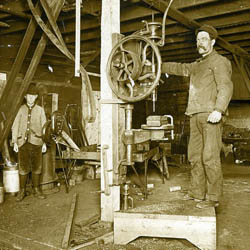The makeup of Saskatchewan's current workforce is far different from that one would have encountered during the settlement era or even in more recent periods. Saskatchewan workers had to adjust to many social and economic changes during the 20th century, some connected to the development and introduction of new technologies, and some to changes within and beyond the province, providing both opportunities and serious challenges. The discovery and rapid exploitation of important mineral and oil deposits since the 1950s is an example of the former. An example of the latter is a sharp and continuous growth in manufacturing in Saskatchewan that has been linked by some to freer access to American and Mexican markets under the North American Free Trade Agreement.
Illustrated on this page and in the Lost Jobs gallery are images of a few of the occupations that once were widely held in the province and which are now little more than memories. It is sometimes easy to describe why a job category may have vanished. In other cases the decline was more gradual and seems to have been determined by a complex of social and economic factors.
Fashion is synomous with change. During much of the early 20th century it was customary for both women and men to wear hats and to dress up when out in public. Expectations in public dress became much more relaxed after the 1960s and milliners, seamstresses and tailors began to disappear from smaller communities as sportswear, usually cheap and imported, became and remained the norm of dress.
The development of new technologies spelled the death knell for many occupations. Blacksmiths, farriers and harness makers were once available in almost every community providing service to the thousands of horses that contributed to farm labour and transportation. The introduction of cars, trucks, and mechanized agricultural vehicles eventually made the working horse redundant.
Ice harvesting and delivery was once an important industry in Saskatchewan. During the winters large blocks of ice were cut and pulled from the shores of Saskatchewan lakes and rivers and transported to nearby storage facilities. During the spring and summer smaller cut blocks of ice were delivered to homes for use in iceboxes and coolers. Safe refrigerants made compact mechanical refrigerators feasible in the 1930s. Ice deliveries declined as access to electricity became more general, encouraging the purchase of refrigerators and many other domestic appliances.
Besides ice many other products were once home delivered, including milk, butter, ice cream, meat, catalogue purchases, wood and coal. A few items such as mail, newspapers, flowers and hot prepared foods are still commonly delivered. The need or desire for home delivery has perhaps been affected by the greater mobility of consumers (two-car families) and by the decline in the number of homes actually occupied during the day. Just a memory are the popular jokes about families where all the children resembled the milkman.
The office, a common workplace for women, has been completely transformed in the last two decades by advances in information processing and communications. Many clerks, stenographers and secretaries were once needed to record transactions, to deal with incoming and outgoing correspondence and to gatekeep access to their management 'superiors.'
Many of the traditional clerical skills have been now made redundant by the introduction of word processing and accounting systems, by the electronic filing and digital storage of documents, and by personal voice and email. Some of the secretary's higher level duties are now performed by the new category of administrative or executive assistant. Many of these positions are still held by females.
Many telephone operators were hired as service expanded across the province. Before the introduction of direct dial systems and automatic exchanges, an operator's help was required for all but the simplest local calls. Most of these positions were occupied by women. Many lost their jobs as Sasktel and other telephone companies moved to reduce their labour costs through advances in communications technology and more recently, through the outsourcing of jobs.



![Blacksmith, ['ca. 1903']](cropthumbs/R-B1793.jpg)

![Purity Dairy Milk Delivery Wagon, ['ca. 1952']](cropthumbs/B-1638.jpg)
![Hauling Ice from River,<br />['between 1900-1920']](cropthumbs/R-A23668.jpg)



![Secretary at Desk at University Hospital, <br />Saskatoon, ['195-']](cropthumbs/B-10533-2.jpg)
![Telephone Operators at Work, <br />Saskatchewan Government Telephones, ['19--?']](cropthumbs/B-6599-A.jpg)
![Telephone Operators at Work, <br />Saskatchewan Government Telephones, ['19--?']](cropthumbs/B-6594.jpg)